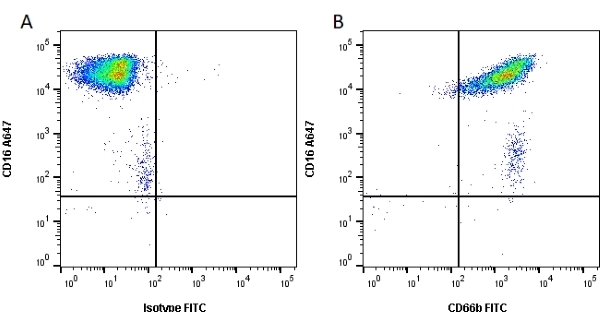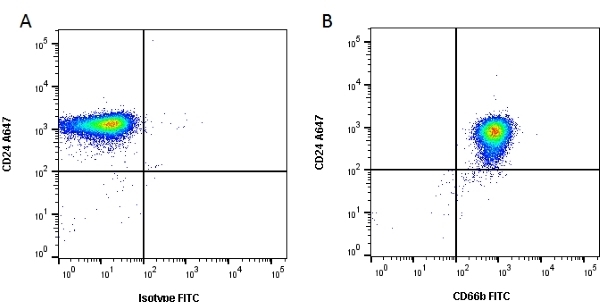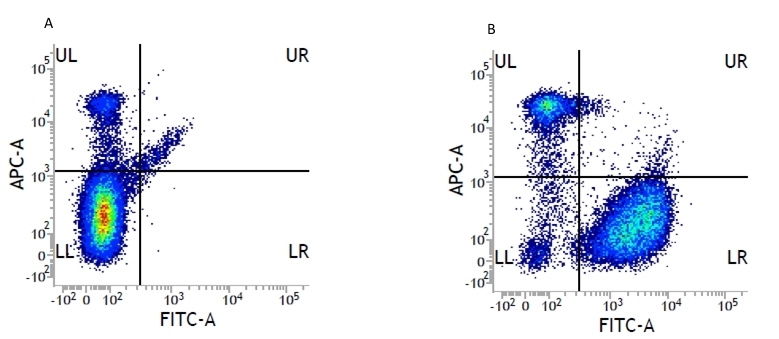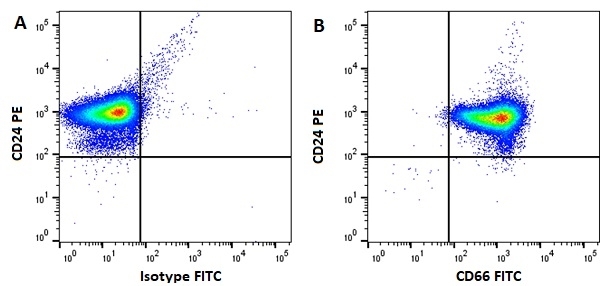CD66b antibody | 80H3




Mouse anti Human CD66b
- Product Type
- Monoclonal Antibody
- Clone
- 80H3
- Isotype
- IgG1
- Specificity
- CD66b
| Mouse anti Human CD66b antibody, clone 80H3 reacts with the CEACAM8 or CGM6 gene product, from the carcinoembryonic gene family. The CEACAM8 gene product is called CD66b, Non-specific cross-reacting antigen NCA-95 or Carcinoembryonic antigen CGM6. CD66b is a 286 amino acid mature ~95-100 kDa GPI anchored molecule with an N-terminal 34 amino acid signal peptide and a 29 amino acid C-terminal propeptide, shed in the mature form. CD66b is expressed strongly by mature granulocytes and metamyelocytes, and weakly by bone marrow myelocytes. CD66b is not expressed by peripheral blood monocytes or lymphocytes. |
- Target Species
- Human
- Product Form
- Purified IgG - liquid
- Preparation
- Purified IgG prepared by affinity chromatography on Protein A from tissue culture supernatant
- Buffer Solution
- MCA216: Phosphate buffered saline.
- MCA216T: Phosphate buffered saline
- Preservative Stabilisers
- <0.1% Sodium Azide (NaN3)
0.5% Bovine Serum Albumin - Immunogen
- Human leucocytes from individuals with CML.
- Approx. Protein Concentrations
- IgG concentration 1.0 mg/ml
- Fusion Partners
- Spleen cells from immunized BALB/c mice were fused with cells of the mouse MOPC 315-43 myeloma cell line.
- Regulatory
- For research purposes only
- Guarantee
- 12 months from date of despatch
Avoid repeated freezing and thawing as this may denature the antibody. Storage in frost-free freezers is not recommended.
| Application Name | Verified | Min Dilution | Max Dilution |
|---|---|---|---|
| Flow Cytometry | 1/20 Pack Size: 0.2 mg 1/50 Pack Size: 20 µg |
1/100 | |
| Functional Assays 1 | |||
| Immunohistology - Frozen 2 | 1/25 | 1/100 | |
| Immunohistology - Paraffin | |||
| Western Blotting 3 |
- 1 This product contains sodium azide, removal by dialysis is recommended prior to use in functional assays.
- 2 The epitope recognised by this antibody is reported to be sensitive to formaldehyde fixation and tissue processing. Bio-Rad recommends the use of acetone fixation for frozen sections.
- 3 See Feuk-Lagerstedt et al.
- Flow Cytometry
- Use 10ul of the suggested working dilution to label 5 x 105 cells or 100ul whole blood.
- Histology Positive Control Tissue
- Bone Marrow
| Description | Product Code | Applications | Pack Size | List Price | Your Price | Quantity | |
|---|---|---|---|---|---|---|---|
| Mouse IgG1 Negative Control | MCA928 | F | 100 Tests |
|
Log in | ||
| List Price | Your Price | ||||||
|
|
Log in | ||||||
| Description | Mouse IgG1 Negative Control | ||||||
Source Reference
-
Mannoni, P. et al. (1982) Monoclonal antibodies against human granulocytes and myeloid differentiation antigens.
Hum Immunol. 5 (4): 309-23.
References for CD66b antibody
-
Rosenkranz, A.R. et al. (1999) Novel C5-dependent mechanism of neutrophil stimulation by bioincompatible dialyzer membranes.
J Am Soc Nephrol. 10: 128-35. -
Feuk-Lagerstedt, E. et al. (1999) Identification of CD66a and CD66b as the major galectin-3 receptor candidates in human neutrophils.
J Immunol. 163: 5592-8. -
Ottonello, L. et al. (1999) Monoclonal Lym-1 antibody-dependent cytolysis by neutrophils exposed to granulocyte-macrophage colony-stimulating factor: intervention of FcgammaRII (CD32), CD11b-CD18 integrins, and CD66b glycoproteins.
Blood. 93: 3505-11. -
Ottonello, L. et al. (2000) Monoclonal Lym-1 antibody-targeted lysis of B lymphoma cells by neutrophils. Evidence for two mechanisms of FcgammaRII-dependent cytolysis.
J Leukoc Biol. 68: 662-8. -
Jankowski, A. et al. (2002) Determinants of the phagosomal pH in neutrophils.
J Biol Chem. 277: 6059-66. -
Thickett, D.R. et al. (2002) A role for vascular endothelial growth factor in acute and resolving lung injury.
Am J Respir Crit Care Med. 166: 1332-7. -
Jinnouchi, A. et al. (2005) Local anesthetics inhibit priming of neutrophils by lipopolysaccharide for enhanced release of superoxide: suppression of cytochrome b558 expression by disparate mechanisms.
J Leukoc Biol. 78: 1356-65. -
Sekine, K. et al. (2006) Panning of multiple subsets of leukocytes on antibody-decorated poly(ethylene) glycol-coated glass slides.
J Immunol Methods. 313: 96-109.
View The Latest Product References
-
Moraes, T.J. et al. (2006) Abnormalities in the pulmonary innate immune system in cystic fibrosis.
Am J Respir Cell Mol Biol. 34: 364-74. -
Binet, F. and Girard, D. (2008) Novel human neutrophil agonistic properties of arsenic trioxide: involvement of p38 mitogen-activated protein kinase and/or c-jun NH2-terminal MAPK but not extracellular signal-regulated kinases-1/2.
J Leukoc Biol. 84: 1613-22. -
Nijhuis, J. et al. (2009) Neutrophil Activation in Morbid Obesity, Chronic Activation of Acute Inflammation
Obesity (Silver Spring). 17: 2014-8. -
Pliyev, B.K. and Menshikov, M.Y. (2010) Release of the soluble urokinase-type plasminogen activator receptor (suPAR) by activated neutrophils in rheumatoid arthritis.
Inflammation. 33: 1-9. -
Simard, J.C. et al. (2010) Induction of neutrophil degranulation by S100A9 via a MAPK-dependent mechanism.
J Leukoc Biol. 87 (5): 905-14. -
Ionita, M.G. et al. (2010) High neutrophil numbers in human carotid atherosclerotic plaques are associated with characteristics of rupture-prone lesions.
Arterioscler Thromb Vasc Biol. 30 (9): 1842-8. -
Orozco-Uribe, M. et al. (2015) Early Exposure of Human Neutrophils to Mycobacteria Triggers Cell Damage and Pro-Inhibitory Molecules, but not Activation
Tuberculosis Ch4 -
Whitmore, L.C. et al. (2016) A Common Genetic Variant in TLR1 Enhances Human Neutrophil Priming and Impacts Length of Intensive Care Stay in Pediatric Sepsis.
J Immunol. 196 (3): 1376-86. -
Bastian, O.W. et al. (2016) Neutrophils contribute to fracture healing by synthesizing fibronectin+ extracellular matrix rapidly after injury.
Clin Immunol. 164: 78-84. -
Dyugovskaya, L. et al. (2016) Intermittent Hypoxia Affects the Spontaneous Differentiation In Vitro of Human Neutrophils into Long-Lived Giant Phagocytes.
Oxid Med Cell Longev. 2016: 9636937. -
Bhan, I. et al. (2018) Detection and Analysis of Circulating Epithelial Cells in Liquid Biopsies From Patients With Liver Disease.
Gastroenterology. 155 (6): 2016-2018.e11. -
Medford, A.J. et al. (2019) Blood-based monitoring identifies acquired and targetable driver HER2 mutations in endocrine-resistant metastatic breast cancer.
NPJ Precis Oncol. 3: 18. -
Ebright, R.Y. et al. (2020) HIF1A signaling selectively supports proliferation of breast cancer in the brain.
Nat Commun. 11 (1): 6311. -
Franses, J.W. et al. (2020) Pancreatic circulating tumor cell profiling identifies LIN28B as a metastasis driver and drug target.
Nat Commun. 11 (1): 3303. -
Fox, D.B. et al. (2023) Downregulation of KEAP1 in melanoma promotes resistance to immune checkpoint blockade.
NPJ Precis Oncol. 7 (1): 25. -
Dubash, T.D. et al. (2023) Modeling the novel SERD elacestrant in cultured fulvestrant-refractory HR-positive breast circulating tumor cells.
Breast Cancer Res Treat. 201 (1): 43-56. -
Guo, H. et al. (2023) DNA hypomethylation silences anti-tumor immune genes in early prostate cancer and CTCs.
Cell. 186 (13): 2765-2782.e28. -
Sundqvist, M. et al. (2018) Similarities and differences between the responses induced in human phagocytes through activation of the medium chain fatty acid receptor GPR84 and the short chain fatty acid receptor FFA2R.
Biochim Biophys Acta Mol Cell Res. 1865 (5): 695-708. -
Horwitz, E. et al. (2024) CDKN1B (p27kip1) enhances drug tolerant persister CTCs by restricting polyploidy following mitotic inhibitors
bioRχiv. 22 Feb [Epub ahead of print].
- Synonyms
- Biliary Glycoprotein
- Carcinoembryonic Antigen Related Cell Adhesion Molecule 8
- RRID
- AB_2229261
- UniProt
- P31997
- Entrez Gene
- CEACAM8
- GO Terms
- GO:0005887 integral to plasma membrane
- GO:0005615 extracellular space
- GO:0006955 immune response
- GO:0031225 anchored to membrane
Please Note: All Products are "FOR RESEARCH PURPOSES ONLY"
View all Anti-Human ProductsAlways be the first to know.
When we launch new products and resources to help you achieve more in the lab.
Yes, sign me up


